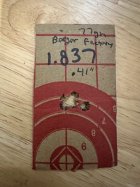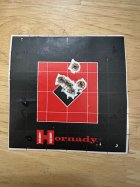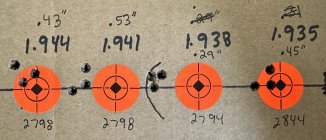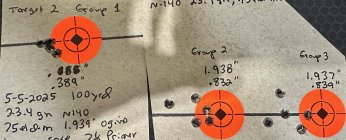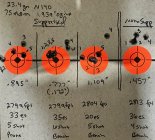Jeffrey Curl
Silver $$ Contributor
I have been using N140 behind the 75gn ELD-M and cannot find a reliable load.
I have a TL3 action with a pre-fit 26" Criterion .223 match chamber (.090" Free bore) heavy bull barrel with a straight taper suppressed with a 7" Thunderbeast .30 cal. I had 90 rounds of factory Berger 77gn OTM Tactical that I ran through the rifle to get a baseline and the Lapua brass. I sorted the ammo by CBTO and found that they varied from 1.833" to 1.840". I did a mini seating depth test and then reseated them all to 1.837" where they shot the best and shot all the remaining rounds with great results. Average MV across 20 rounds was 2798 fps. I noticed 2 issues doing this.
1. With 5 shot groups I always seemed to have one flyer. With the flyer, the groups would run around .416" to .618" with a seating depth of 1.837". Without the flyer, the groups were .245" to .512". This flyer was not me. I am shooting at 100 yards with a 1 lb trigger, loaded bipod, heavy rear bag, all parallax dialed out and little to no mirage. I am using 36x and very close to dead on with every trigger break. I am directly behind the gun. On cloudy days, I'm shooting prone and on sunny days, I'm shooting from a bench for reduce mirage.
2. Small changes in seating depth with the Berger factory seemed to matter a lot with the below 5 shot groups all shot on the same day.
a. 1.833"=.626"
b. 1.837"=.422"
c. 1.838"=.943"
d. 1.839"=.802"
e. 1.840"=.926"
So I started load development. In the past, I have loaded for .308, .300bo, 6.5cm (2 different rifles), and 7ss and very happy with the results. I have always used the OCW method with some variances from time to time followed by seating depth test. I have actually loaded .223 before but that was for an AR where I expected less accuracy then my bolt guns.
I full length sized the Lapua brass using a full length Forstor die until the bolt with the firing pin removed closed with no resistance. The guts are removed from the die. I am using a .222 expander mandrel for neck tension. I trimmed all the cases to the same length. During this process, I used 7 1/2 primers and N140 Powder. I have 7 boxes of 75gn ELD all from the same lot. All powder charges were weighed with an FX-120i.
I did a Satterly/pressure type test from 22.3 gn to 25.6 gn with a chronograph and the bullet seated .020" off the lands. I identified a couple of spots in velocity and where the bullets printed close on paper and the ES was not bad. One combination was 23.2 and 23.5 gn at 2790 and 2834 respectively. They printed on paper within .22". I loaded up 5 rounds at 23.36 gn with a velocity of 2791 and it shot 1". I did the same thing with 2 other areas of interest at higher velocities and they all shot about 1".
I liked the 2800 fps velocity range which was also the same as the Factory Berger so I also loaded up a seating depth test for 23.4 gn from 1.962 cbto which is .007 jump all the way to 1.908" cbto for a little more then .060 jump at .003 increments (19 groups). I got very good results on 3 shot groups from 1.944" to 1.935" including .29" group at 1.938. However, when I shot 5 shot verification loads it went to crap again.
I also explored several other areas at higher velocities that looked promising on the Satterly test but all went to crap at verification.
I am currently working on the 3rd loading of the brass and plan to Anneal after finishing up the 3rd firing. I now have 274 rounds on the barrel.
ALL shots including the Berger's were done with the suppressor. Just for grins, I did take the suppressor off for the very last group I shot with the 23.4 gn load at 1.939" and it did tighten up to .457 but even it still had the one flyer.
Any suggestions are greatly appreciated. I really expected to achieve .5" groups with frequent smaller groups so I am quite disappointed with these targets and consistent flyers. My next thoughts are the following:
1. Rerun the workup using OCW but at what starting seating depth (gun seems very picky about seating depth) using 75 eld and N140.
2. Switch to 2920 which I have but that is a ball powder and we get 100 degree temps in SE Texas. I would like a year round load.
3. Try the Sierra 77 gn with cannelure which I have just to try another bullet.
4. Buy expensive Bergers for plinking... Ugh.
The first 2 photographs are with Factory Bergers seated over .100" from the lands.
The 3rd is a close up of part of the seating depth test at 23.4 gns
The 4th is 5 shot verifications using 1.939, 1.938, and 1.937. I thought I was on to something with 1.939.
The 5th is verification with 1.939 falling completely apart with flyers.
Any thoughts or help would be much appreciated.
I have a TL3 action with a pre-fit 26" Criterion .223 match chamber (.090" Free bore) heavy bull barrel with a straight taper suppressed with a 7" Thunderbeast .30 cal. I had 90 rounds of factory Berger 77gn OTM Tactical that I ran through the rifle to get a baseline and the Lapua brass. I sorted the ammo by CBTO and found that they varied from 1.833" to 1.840". I did a mini seating depth test and then reseated them all to 1.837" where they shot the best and shot all the remaining rounds with great results. Average MV across 20 rounds was 2798 fps. I noticed 2 issues doing this.
1. With 5 shot groups I always seemed to have one flyer. With the flyer, the groups would run around .416" to .618" with a seating depth of 1.837". Without the flyer, the groups were .245" to .512". This flyer was not me. I am shooting at 100 yards with a 1 lb trigger, loaded bipod, heavy rear bag, all parallax dialed out and little to no mirage. I am using 36x and very close to dead on with every trigger break. I am directly behind the gun. On cloudy days, I'm shooting prone and on sunny days, I'm shooting from a bench for reduce mirage.
2. Small changes in seating depth with the Berger factory seemed to matter a lot with the below 5 shot groups all shot on the same day.
a. 1.833"=.626"
b. 1.837"=.422"
c. 1.838"=.943"
d. 1.839"=.802"
e. 1.840"=.926"
So I started load development. In the past, I have loaded for .308, .300bo, 6.5cm (2 different rifles), and 7ss and very happy with the results. I have always used the OCW method with some variances from time to time followed by seating depth test. I have actually loaded .223 before but that was for an AR where I expected less accuracy then my bolt guns.
I full length sized the Lapua brass using a full length Forstor die until the bolt with the firing pin removed closed with no resistance. The guts are removed from the die. I am using a .222 expander mandrel for neck tension. I trimmed all the cases to the same length. During this process, I used 7 1/2 primers and N140 Powder. I have 7 boxes of 75gn ELD all from the same lot. All powder charges were weighed with an FX-120i.
I did a Satterly/pressure type test from 22.3 gn to 25.6 gn with a chronograph and the bullet seated .020" off the lands. I identified a couple of spots in velocity and where the bullets printed close on paper and the ES was not bad. One combination was 23.2 and 23.5 gn at 2790 and 2834 respectively. They printed on paper within .22". I loaded up 5 rounds at 23.36 gn with a velocity of 2791 and it shot 1". I did the same thing with 2 other areas of interest at higher velocities and they all shot about 1".
I liked the 2800 fps velocity range which was also the same as the Factory Berger so I also loaded up a seating depth test for 23.4 gn from 1.962 cbto which is .007 jump all the way to 1.908" cbto for a little more then .060 jump at .003 increments (19 groups). I got very good results on 3 shot groups from 1.944" to 1.935" including .29" group at 1.938. However, when I shot 5 shot verification loads it went to crap again.
I also explored several other areas at higher velocities that looked promising on the Satterly test but all went to crap at verification.
I am currently working on the 3rd loading of the brass and plan to Anneal after finishing up the 3rd firing. I now have 274 rounds on the barrel.
ALL shots including the Berger's were done with the suppressor. Just for grins, I did take the suppressor off for the very last group I shot with the 23.4 gn load at 1.939" and it did tighten up to .457 but even it still had the one flyer.
Any suggestions are greatly appreciated. I really expected to achieve .5" groups with frequent smaller groups so I am quite disappointed with these targets and consistent flyers. My next thoughts are the following:
1. Rerun the workup using OCW but at what starting seating depth (gun seems very picky about seating depth) using 75 eld and N140.
2. Switch to 2920 which I have but that is a ball powder and we get 100 degree temps in SE Texas. I would like a year round load.
3. Try the Sierra 77 gn with cannelure which I have just to try another bullet.
4. Buy expensive Bergers for plinking... Ugh.
The first 2 photographs are with Factory Bergers seated over .100" from the lands.
The 3rd is a close up of part of the seating depth test at 23.4 gns
The 4th is 5 shot verifications using 1.939, 1.938, and 1.937. I thought I was on to something with 1.939.
The 5th is verification with 1.939 falling completely apart with flyers.
Any thoughts or help would be much appreciated.










